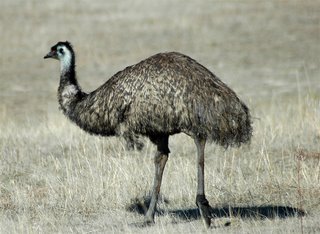There are no Emus
(Dromaius novaehollandiae) in Robertson, and there are no truly wild Emus in Canberra, but there were Emus there when the first settlers arrived. That fact is documented in a book by my father, Steve Wilson, called
"Birds of the ACT - two centuries of change" (published by the Canberra Ornithologists Group).
 When Tidbinbilla Nature Reserve was first established, sometime in the 1970s, Emus were re-introduced to the area, to recognise the fact that they were originally in the area. There were occasional reports of wild Emus in the high plains country, very high in the Alps, during the 1980s. Anyway, some of the Emus of the Tidbinbilla area survived the devastating bushfires of January 2003, and are still roaming the sheep paddocks below the main area of the Reserve.
When Tidbinbilla Nature Reserve was first established, sometime in the 1970s, Emus were re-introduced to the area, to recognise the fact that they were originally in the area. There were occasional reports of wild Emus in the high plains country, very high in the Alps, during the 1980s. Anyway, some of the Emus of the Tidbinbilla area survived the devastating bushfires of January 2003, and are still roaming the sheep paddocks below the main area of the Reserve.
Emus are said to be extremely primitive birds, and along with the Cassowary, Ostriches, Rheas and the diminutive New Zealand Kiwi they are grouped together in a Order of birds called Ratites. All are flightless birds, with coarse feathers. They do not have a deep bone on their sternum where normal birds have their strong wing-beating muscles attached. (- for contrast, have a look at the chest bone of the next Chicken you consume).
 From my point of view, I consider that Emus and other Ratites are in fact highly evolved birds, which have abandoned the power of flight. They do have wings, just remnant wings which are totally useless for flight. To me, it makes sense to regard these as obsolescent organs, remnants of formerly useful structures, which they no longer need.
From my point of view, I consider that Emus and other Ratites are in fact highly evolved birds, which have abandoned the power of flight. They do have wings, just remnant wings which are totally useless for flight. To me, it makes sense to regard these as obsolescent organs, remnants of formerly useful structures, which they no longer need.
The left wing of this Emu is clearly visible in the photo at left, just in front of the leg. It is hanging down below the line of the body.
Female Emus lay their eggs in autumn and winter, and the male then sits on the eggs, and broods the young, and raises them. This apparent "family group" might be a female (the larger bird) and a male, in the middle with two chicks from two years ago. Alternatively, it might be a male. with three chicks. I cannot tell, but I favour the first explanation, as the middle bird is showing some of the adult blue colouring on its neck. The only problem is that Emus are not sentimental birds, and do not tend to hang around in "family groups". Partly this is explaimed by the need of the female to be able to reproduce by laying large clutches (up to 15 eggs) of huge eggs, which is a great reproductive burden. To do this, she needs to be in peak physical condition.
So the Nature of Emus is something of a mystery.

































